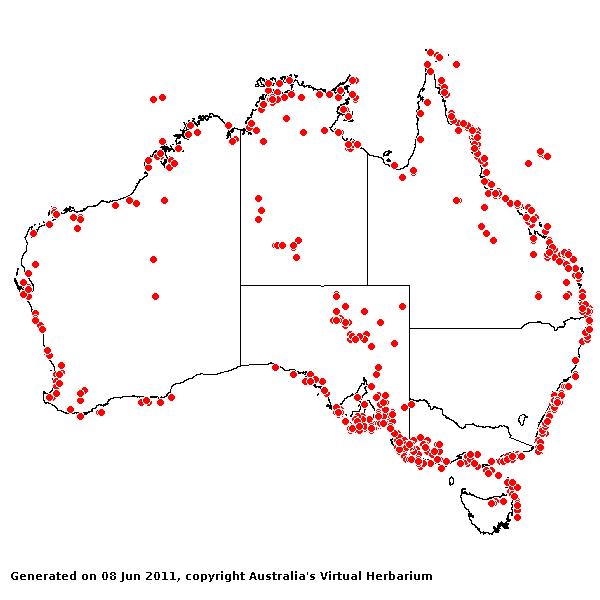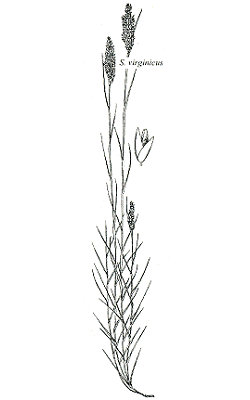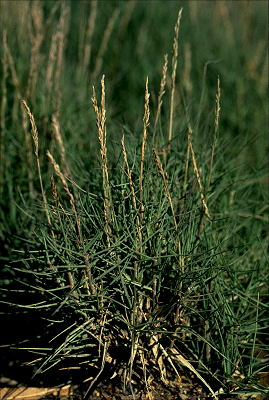Sporobolus virginicus (L.) Kunth. Rev. Gram. 1:67 (1829).
Classification. (GPWG 2001) : Subfamily Chloridoideae. Cynodonteae.
Basionym and/or Replacement Name: Agrostis virginica L., Sp. Pl. 1: 63 (1753).
Type of Basionym or Protologue Information: LT: J. Clayton 507, USA: habitat in Virginia (LINN-84.30; ILT: BM, US-76294 (fragm. ex BM)). LT designated by Hitchcock, Contr. U.S. Natl. Herb. 12: 119 (1908).
Key references (books and floras): [1810]. R.Brown, Prodromus (170 as Agristis virginica), [1952] C.A.Gardner, Flora of Western Australia 1 Gramineae (160), [1981] M.Lazarides in J.Jessop (ed)., Flora of Central Australia (469), [2002] D.Sharp & B.K.Simon, AusGrass, Grasses of Australia, [2002] J.Wheeler, N.Marchant & M.Lewington, Flora of the South West (436), [2006] J.Jessop, G.R.M.Dashorst, F.M.James, Grasses of South Australia (401), [2008] S.W.L.Jacobs, R.D.B.Walley & D.J.B.Wheeler, Grasses of New South Wales (380).
Illustrations: [1952] C.A.Gardner, Flora of Western Australia 1 Gramineae (161, Pl. 48), [2006] J.Jessop, G.R.M.Dashorst, F.M.James, Grasses of South Australia (401, Fig. 334), [2008] S.W.L.Jacobs, R.D.B.Whalley & D.J.B.Wheeler, Grasses of New South Wales, 4th edn (380).
Habit. Perennial. Rhizomes present, elongated. Stolons absent or present. Culms erect or decumbent, 10–50 cm tall, 1–2 mm diam. Lateral branches branched. Ligule a fringe of hairs, 0.25 mm long. Leaf-blades linear, flat or convolute, 2–13 cm long, 1–4 mm wide.
Inflorescence. Inflorescence solid, a panicle. Panicle linear, 2–15 cm long, (0.3–)0.6–0.8(–1) cm wide, evenly furnished.
Spikelets. Spikelets sessile or pedicelled. Fertile spikelets 1-flowered, comprising 1 fertile floret(s), without rachilla extension, lanceolate, terete, 1.7–4 mm long.
Glumes. Glumes similar. Lower glume linear or lanceolate, membranous, without keels, 1–2 -nerved. Upper glume lanceolate or ovate, 1.7–3.6 mm long, membranous, without keels, 1 -nerved.
Florets. Fertile lemma 1.7–3.6 mm long, without keel, 1 -nerved. Palea 2 -nerved. Palea apex lobed. Anthers 3. Grain 0.7–0.9 mm long.
Continental Distribution: Europe, Africa, Temperate Asia, Tropical Asia, Australasia, Pacific, North America, and South America.
Australian Distribution: Western Australia, Northern Territory, South Australia, Queensland, New South Wales, Victoria, Tasmania, Lord Howe, Christmas Is, Cocos Keeling Is, Ashmore Reef, Coral Sea Is.
Western Australia: Gardner, Fitzgerald, Dampier. Canning, Fortescue, Carnarvon, Austin. Irwin, Drummond, Menzies, Warren, Eyre, Avon. Northern Territory: Darwin & Gulf, Barkly Tableland, Central Australia North, Central Australia South. South Australia: Lake Eyre, Nullabor, Gairdner-Torrens Basin, Flinders Ranges, Eyre Peninsula, Northern Lofty, Murray, Yorke Peninsula, Southern Lofty, Kangaroo Island, South-eastern. Queensland: Burke, Cook, Moreton, North Kennedy, Port Curtis, South Kennedy, Wide Bay, Leichhardt, Burnett, Mitchell. New South Wales: North Coast, Central Coast, South Coast, Northern Tablelands, Southern Tablelands. Victoria: East Gippsland, Gippsland Plain, Grampians, Otway Plain, Otway Range, Volcanic Plain, Wannon, Wimmera. Tasmania: Furneaux Group, North East, East Coast.
Notes. A halophytic polymorphic species with several different ploidy levels, distributed world wide. Smith-White (1988, 1990) recognised 4 main morphological types which have a loose association with the level of ploidy, but he refrained from giving them formal names due to the large number of intermediates. In general ploidy levels are higher in tropical regions.
A narrow leaved form (var. minor) and a broad leaved form (var. virginicus) have been described previously and maintained in recent floras (Jacobs & MaClay 1993). A form along the coast of southern Australia has small dark compact ovoid panicles and has been given a manuscript name susp. australis (R. Mills ms) but it is probably not worth recognition for similar reasons to those stated by Smith-White. The species differs from S. mitchelli by having longer spiklets, by the leaf sheaths usually being longer than the internodes, and by being rhizomatous as opposed to stoloniferous.
All coastal regions and also many inland regions with saline influence; Eastern Asia, Africa, and the Pacific region. Mainly restricted to maritime habitats with some records also from saline localities areas from inland and central Australia; flowers all year, but mainly during the warm months.








